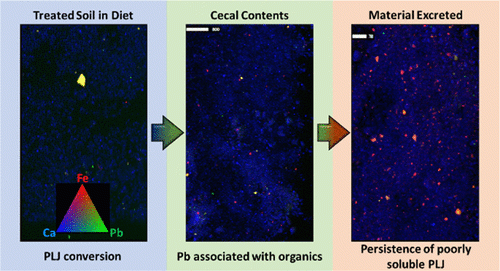EPA Researchers Exploring Innovative Treatment for Lead in Soil

Published March 15, 2022
While lead exposure has decreased significantly over the past few decades, lead pollution lingering in soil still poses health risks for many urban communities. Lead exposure is particularly dangerous to children, leading to severe intellectual disabilities along with other lifetime health impacts. EPA researchers are working to reduce childhood lead exposure by exploring new ways to clean up lead in contaminated sites.
EPA researchers and partners are working on methods to turn toxic lead into less harmful forms through soil additives. Successful soil additives, or amendments, would interact with lead contamination and make it insoluble if ingested. Not all soil additives work for every type of soil or site, so researchers and contaminated site managers are exploring new options for reducing health risks.
An EPA team previously showed for the first time that a method that converted lead into a mineral called plumbojarosite was highly effective at reducing the bioavailability of lead—in other words, the method reduced how easily lead is absorbed into the body. Their novel strategy involved adding iron sulfate and applying heat to lead-contaminated soils, which converted soil lead phases into plumbojarosite, reducing the bioavailability by more than 90%.
Now, the team has published another study exploring how the plumbojarosite treatment affects lead interactions in the body, providing new insights into its potential as a soil amendment.
“We wanted to explore this concept further by looking at the microscale to see what phase of lead is present and how it interacts with other elements,” says EPA researcher Tyler Sowers, the lead author of the study. “We gained a new perspective on how lead interacts with other parts of the body and showed that plumbojarosite works with other types of soil that we hadn’t previously tested.”
The team conducted mouse assays using contaminated soil with and without the plumbojarosite treatment to see which forms of lead were absorbed into the gastrointestinal system or excreted. Through technology called X-ray absorption spectroscopy, they could examine the elemental reactions happening in the gastrointestinal tract and confirm that lead converted to plumbojarosite was not significantly absorbed by the body.
“We expected this method to work based on the stability of the mineral in acidic conditions like you would find in the gastrointestinal tract, but the bioavailability was incredibly low—less than one percent," says Sowers.
Reducing lead bioavailability to less than ten percent would be enough to remediate many lead-contaminated sites, says co-author Kirk Scheckel. With the reduction shown in this study, he says, plumbojarosite treatment could remediate soils with lead levels up to 3,000 parts per million. Many contaminated sites are well below this threshold.
Studies like these are important because traditional methods of remediating lead contamination, like removing the soil or using other soil amendments like biochar, are costly and sometimes ineffective.
“Lead contamination is expensive to clean up – you have to remove the top 12-16 inches of soil at an estimate in excess of a million dollars per acre,” says co-author Karen Bradham.
Previously studied soil amendments can capture lead in the soil, but do not reduce bioavailability as effectively—leaving a potential health risk for future generations. Finding alternatives that reduce the bioavailability of lead enough to allow the soil to remain in place would save money and better protect children’s health. This latest study suggests plumbojarosite treatment may be a useful method to remediate contaminated soils.
The team’s next goals are to explore the method’s potential to also remediate arsenic, which often occurs alongside lead contamination, and to conduct field tests in real-world contaminated sites. They are also developing a method that will not require high heat to promote plumbojarosite in soil, which will remove a major barrier to real-world application.
“We are exploring a simple way to apply this in a field setting – once that’s figured out, we expect it to be a tremendous success,” Scheckel says.
Lead Exposure through Household Dust and Soil: EPA Researchers Looking for a Solution
New Testing Method for Lead and Arsenic in Contaminated Soil Saves Money and Protects Public Health
